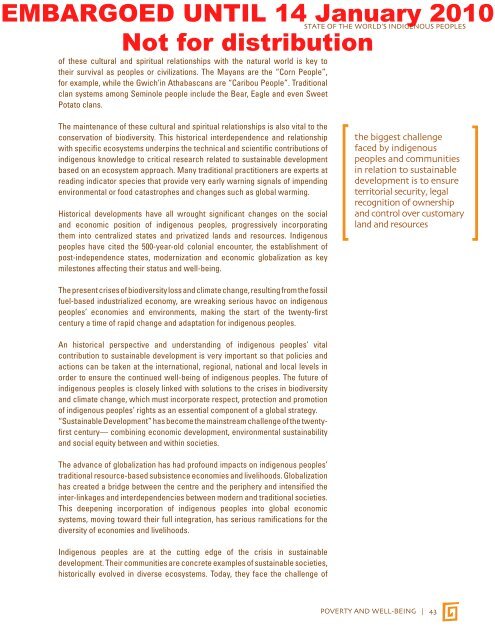STATE OF THE WORLD's INDIGENOUs PEOpLEs - CINU
STATE OF THE WORLD's INDIGENOUs PEOpLEs - CINU
STATE OF THE WORLD's INDIGENOUs PEOpLEs - CINU
- No tags were found...
Create successful ePaper yourself
Turn your PDF publications into a flip-book with our unique Google optimized e-Paper software.
EMBARGOED UNTIL 14 January 2010<strong>STATE</strong> <strong>OF</strong> <strong>THE</strong> WORLD’S INDIGENOUS PEOPLESNot for distributionof these cultural and spiritual relationships with the natural world is key totheir survival as peoples or civilizations. The Mayans are the “Corn People”,for example, while the Gwich’in Athabascans are “Caribou People”. Traditionalclan systems among Seminole people include the Bear, Eagle and even SweetPotato clans.The maintenance of these cultural and spiritual relationships is also vital to theconservation of biodiversity. This historical interdependence and relationshipwith specific ecosystems underpins the technical and scientific contributions ofindigenous knowledge to critical research related to sustainable developmentbased on an ecosystem approach. Many traditional practitioners are experts atreading indicator species that provide very early warning signals of impendingenvironmental or food catastrophes and changes such as global warming.Historical developments have all wrought significant changes on the socialand economic position of indigenous peoples, progressively incorporatingthem into centralized states and privatized lands and resources. Indigenouspeoples have cited the 500-year-old colonial encounter, the establishment ofpost-independence states, modernization and economic globalization as keymilestones affecting their status and well-being.the biggest challengefaced by indigenouspeoples and communitiesin relation to sustainabledevelopment is to ensureterritorial security, legalrecognition of ownershipand control over customaryland and resourcesThe present crises of biodiversity loss and climate change, resulting from the fossilfuel-based industrialized economy, are wreaking serious havoc on indigenouspeoples’ economies and environments, making the start of the twenty-firstcentury a time of rapid change and adaptation for indigenous peoples.An historical perspective and understanding of indigenous peoples’ vitalcontribution to sustainable development is very important so that policies andactions can be taken at the international, regional, national and local levels inorder to ensure the continued well-being of indigenous peoples. The future ofindigenous peoples is closely linked with solutions to the crises in biodiversityand climate change, which must incorporate respect, protection and promotionof indigenous peoples’ rights as an essential component of a global strategy.“Sustainable Development” has become the mainstream challenge of the twentyfirstcentury— combining economic development, environmental sustainabilityand social equity between and within societies.The advance of globalization has had profound impacts on indigenous peoples’traditional resource-based subsistence economies and livelihoods. Globalizationhas created a bridge between the centre and the periphery and intensified theinter-linkages and interdependencies between modern and traditional societies.This deepening incorporation of indigenous peoples into global economicsystems, moving toward their full integration, has serious ramifications for thediversity of economies and livelihoods.Indigenous peoples are at the cutting edge of the crisis in sustainabledevelopment. Their communities are concrete examples of sustainable societies,historically evolved in diverse ecosystems. Today, they face the challenge ofPOVERTY AND WELL-BEING | 43
















